ASUS P8Z68-V PRO Review: Our First Z68 Motherboard
by Ian Cutress on May 11, 2011 3:13 AM EST- Posted in
- Motherboards
- Asus
- Z68
LAN Speed Test
LAN Speed Test is a freeware program designed for testing the network connection between two PCs on a home network. The speed of the transfer is limited by the lowest common denominator on the network, so if you have gigabit Ethernet capable computers but a 100 Mbit capable router, you are limited to 100 Mbit transfer. Note that this is really a formality – if a network port is rated at 1 Gbps, then chances are that it will hit at least 90+% of this value. The main test here is CPU usage, and how much is offloaded by the controller. For this test, we use LAN Speed Test to transfer a 1000 MB file across a home network with a 100 Mbps lowest common speed to the same machine each time, in a read/write scenario. CPU usage is taken as a visual max/average from task manager.
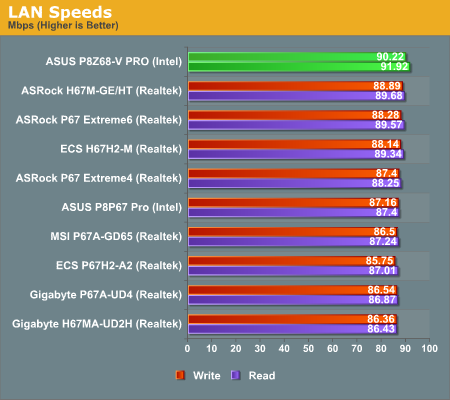
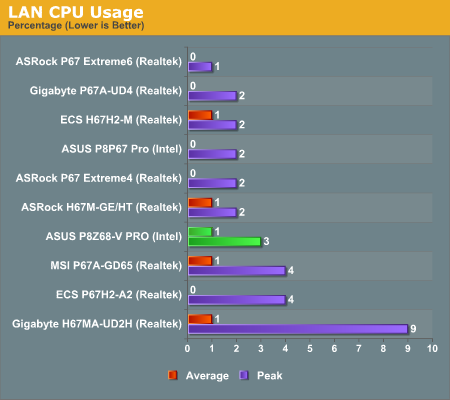
The board comes top in our read/write speed test by a decent margin, considering the 100 Mbps limit imposed by our router.
USB Speed
For this benchmark, we run CrystalDiskMark to determine the ideal sequential read and write speeds for the USB port using our 64GB Patriot SuperSpeed USB 3.0 drive. Then we transfer a set size of files from the SSD to the USB drive, and monitor the time taken to transfer. The files transferred are a 1.52 GB set of 2867 files across 320 folders – 95% of these files are small typical website files, and the rest (90% of the size) are the videos used in the Sorenson Squeeze test.

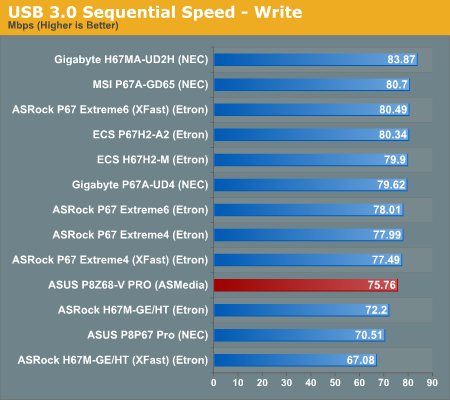
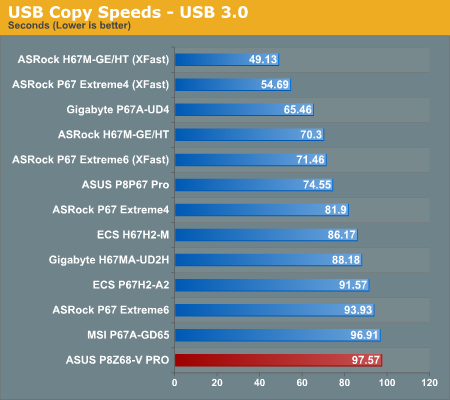
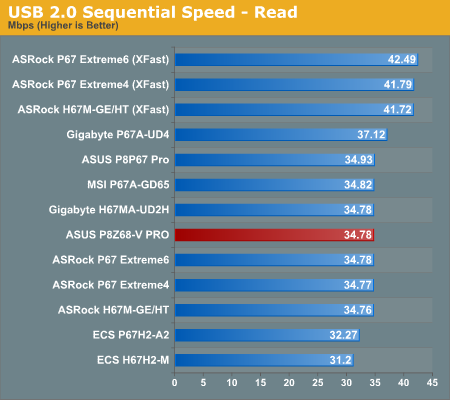


The board isn't setting any USB records, being near the bottom compared to other boards we've tested.
SATA Testing
We also use CrystalDiskMark for SATA port testing. The operating system is installed on the Micron RealSSD C300, which is rated at 355 MB/s read and 215 MB/s write, and the sequential test is run at the 5 x 1000 MB level. This test probes the efficiency of the data delivery system between the chipset and the drive, or in the case of additional SATA ports provided by a third party controller, the efficiency between the controller, the chipset and the drive.
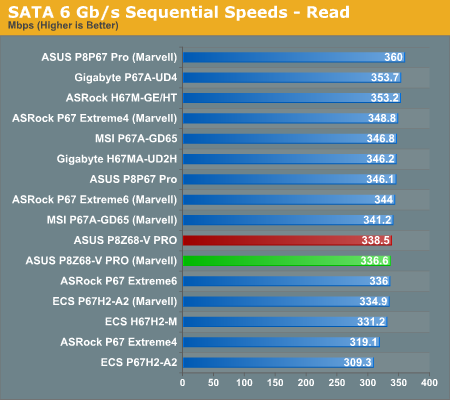
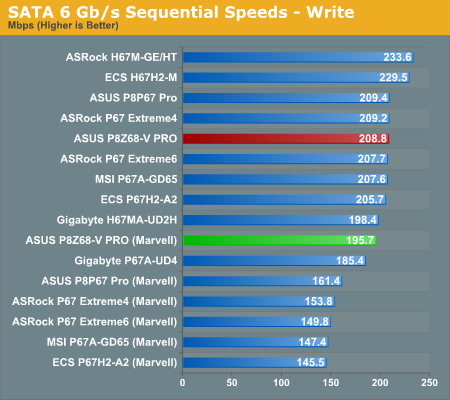

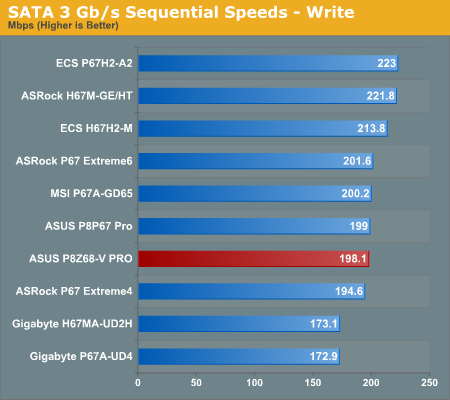
The ASUS board is near the middle of the pack when it comes to SATA speeds.
DPC Latency
Deferred Procedure Call latency is a way in which Windows handles interrupt servicing. In order to wait for a processor to acknowledge the request, the system will queue all interrupt requests by priority. Critical interrupts will be handled as soon as possible, whereas lesser priority requests, such as audio, will be further down the line. So if the audio device requires data, it will have to wait until the request is processed before the buffer is filled. If the device drivers of higher priority components in a system are poorly implemented, this can cause delays in request scheduling and process time, resulting in an empty audio buffer – this leads to characteristic audible pauses, pops and clicks. Having a bigger buffer and correctly implemented system drivers obviously helps in this regard. The DPC latency checker measures how much time is processing DPCs from driver invocation – the lower the value will result in better audio transfer at smaller buffer sizes. Results are measured in microseconds and taken as the peak latency while cycling through a series of short HD videos—under 500 microseconds usually gets the green light, but the lower the better.
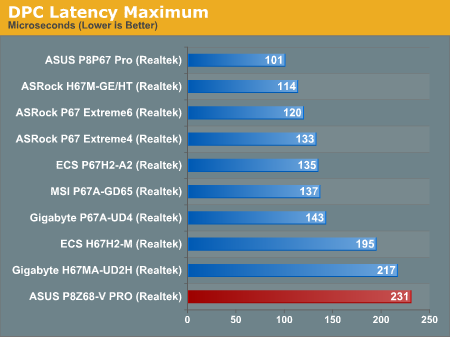
The ASUS board may have come bottom in the DPC test, but the result is stil under 500 microseconds, and for the most part it was under 120.










95 Comments
View All Comments
fr500 - Thursday, May 12, 2011 - link
Not any new crashes but there are crashes now and them with certain nvidia driver versions on TF2 for instance. With an aditional layer on top it makes it worse I guess...Also I said that about control panels because of techreport's review but it seems they didn't know about d mode
AnnihilatorX - Thursday, May 12, 2011 - link
Anand noted that Intel said (when virtu didn't exist), to use QuickSync in Z68, one needs to use 2 monitors.So basically you can have 2 separate monitors, one connection from discrete and one from onboard.
L. - Thursday, May 12, 2011 - link
I'm pretty sure you can come up with more complex and useless examples of using relatively bad technology, namely Lucid.As long as you have a real gpu, you should not be using the IGP at all, that is not going to change anytime soon as 7% of a real GPU >>> anything Intel ever made.
Not to worry though, Virtu will be gone very soon, like Hydra.
"Normally", you should be able to send the transcoding to your GPU and have 3d / screen input at the same time.
In other words : intel IGP bad except if you don't have anything else, virtu bad always unless your GPU is really bad too (wtf?).
This will become more interesting when AMD starts selling Llano, as llano's gpu will be much stronger than Intel's IGP and using both ressources efficiently (discrete+igp) will make a real difference.
fr500 - Thursday, May 12, 2011 - link
The whole deal with this is QuickSync is really fast for transcoding.I don't like the idea of Hydra either so I think using a spare input from your monitor could work, it would still be detected even if the input is not the current active one and even if it doesn't get detected you could just select the other input, do your transcoding and be done with it.
cbgoding - Wednesday, May 11, 2011 - link
So 1.42V was your safe limit, but under load it jumped to 1.544 V?What the hell?
AnnihilatorX - Thursday, May 12, 2011 - link
He wrote 'but'. He's suggesting a bug in the TurboV softwarecbgoding - Friday, May 13, 2011 - link
alright, makes sense. Guess I'll never use TurboV, I'd shit a brick if i had a .124V spike.L. - Thursday, May 12, 2011 - link
My mobo does that ... although I went a bit hard on the pencilmod on purpose - which gives me a vload > vidle (although very close, it's about .025 more).DBissett - Thursday, May 12, 2011 - link
Sorry for grammar policing but some grammar is so bad it makes reading otherwise good articles impossible. "Asus" and "Intel" are companies, singular nouns, and require singular verbs. To say "Asus have" and "Intel have" is not only technical incorrect but just plain reads very badly. "Asus has...." and "Intel has...." is the correct grammatical form. Or if you have to use plural verbs then try "People at Asus have..." for example, and now you've got a plural subject.Dave
IanCutress - Friday, May 13, 2011 - link
Hi Dave,This is one of the (many) differences between British and American English. I attempt to write in an American style for AnandTech, but as I am British, a few things scrape through the net.
All the best,
Ian